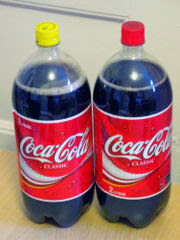
Researchers have found new evidence that soft drinks and other products sweetened with high-fructose corn syrup (HFCS) may contribute to the development of Type 2 diabetes and obesity, particularly in children. The occurrence of new cases of type 2 diabetes has doubled over the past three decades, according to a report in the American Heart Association's journal Circulation - June 2006. The percentage of overweight children in the United States has tripled since 1980.
The epidemic of type 2 diabetes cases across the nation is likely to lead to a substantially higher incidence of strokes among middle-aged adults and newly diagnosed diabetics. In a laboratory study (Rutgers University) of commonly consumed carbonated beverages, the scientists found that drinks containing the syrup had high levels of reactive compounds that are associated with Diabetes, which is at epidemic levels, and that may cause cell damage. Glucose is metabolized in every cell in the body but all fructose must be metabolized in the liver. While naturally occurring sugars, as well as sucrose, contain fructose bound to other sugars, high fructose corn syrup contains a good deal of "free" or unbound fructose. Research indicates that this free fructose interferes with the heart’s use of key minerals like magnesium, copper and chromium. The temporary spike of HFCS blocks the action of insulin, which typically regulates how body cells use and store sugar and other food nutrients for energy. If uric acid levels are frequently elevated, over time features of metabolic syndrome may develop, including high blood pressure, obesity and elevated blood cholesterol levels. Among other consequences, HFCS has been also been implicated in elevated blood cholesterol levels and the creation of blood clots.
Ask any first year MBA student for the biggest story from 1985 and they will mention the "New Coke" debacle-- Coca-Cola briefly replacing its original drink with a new sweeter version which was quickly dropped. An even bigger story however is that 1985 is also the year that Coke and many other soft drink bottlers replaced sugar with High Fructose Corn Syrup in their products to save costs. Sugar prices are boosted by price controls that made using corn syrup appealing to the manufacturers.
So, the"original formula" Coke actually came back as a whole new product with all the fanfare, the ingredients were overlooked. HFCS was developed in the 70's and is found in soft drinks, sports drinks, iced tea, lemonade, sliced bread, processed meats, cakes, pancake syrup, cough syrup and other products. HFCS is created by a complex industrial process performed in
 refineries involving centrifuges, and other high-tech equipment. Starch is extracted from corn and then converted by acids or enzymes to glucose. Then, some of the glucose is further converted by enzymes into fructose. Recently some soft drink manufacturers were ordered to rmove the term natural from the labels of drinks made with the syrup. Some smaller soft drink manufacturers such as Thomas Kemper Soda in Oregon have already begun to listen to consumers and to reformulate their soda with sugar. I recently talked to a representative of coca cola who admitted to me that his children like the taste of Mexican coke-- which is made with real sugar--
refineries involving centrifuges, and other high-tech equipment. Starch is extracted from corn and then converted by acids or enzymes to glucose. Then, some of the glucose is further converted by enzymes into fructose. Recently some soft drink manufacturers were ordered to rmove the term natural from the labels of drinks made with the syrup. Some smaller soft drink manufacturers such as Thomas Kemper Soda in Oregon have already begun to listen to consumers and to reformulate their soda with sugar. I recently talked to a representative of coca cola who admitted to me that his children like the taste of Mexican coke-- which is made with real sugar-- much better and ask him to buy it when he sees it. Also Coca-Cola made for Passover (with a yellow cap) contains sugar instead of HFCS. Again, many claim it tastes better.
much better and ask him to buy it when he sees it. Also Coca-Cola made for Passover (with a yellow cap) contains sugar instead of HFCS. Again, many claim it tastes better.Escalating corn prices and rapid increases in high fructose corn syrup prices may encourage a wider return to sugar usage in U.S. soft drink and food production. It will be interesting to see if sugar does return to replace HFCS, and if the data trend on obesity and diabetes show a corresponding improvement. Until then there is one drink that contains no HFCS-- good old H20.
Update: For further information on how your body processes HFCS: http://www.huffingtonpost.com/dr-mercola/sugar-may-be-bad-but-this_b_463655.html
No comments:
Post a Comment